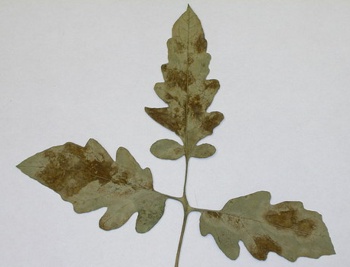Diseases
Cladosporium fulvum Cooke - Cladosporium Leaf and Fruit Mold of Tomatoes
Systematic position.
Division Ascomycota, order Dothideales, family Mycosphaerellaceae, genus Cladosporium.Synonyms.
Fulvia fulva (Cooke) Ciferri.Biological group.
Facultative parasite.Morphology and biology.
First symptoms of the disease appear on the lower leaves, and then all of the plant is affected. Yellowish-brown spots are formed on the upper side of leaves, and opposite to these spots, the velvety blooming (yellowish in the beginning, later reddish-brown) of fungus sporification develops on the lower side of leaves. Conidiophores simple, sometimes branching, straight or twisting, narrow at base, thickening upward, pale or olive-brown, to 200 microns long, rising from stomata; conidia unicellular, 12-47 x 4-10 microns, light brown, smooth, arranged in chains. The affected leaves turn yellow and dry up.Distribution.
The Cladosporiosis was, for the first time, registered in the former USSR in 1925, proving more harmful under conditions of protected culture (greenhouse); since 1965 the disease was found in open ground in Georgia, and since 1977 in the Leningrad Region, then in Moldova, Krasnodar Territory, and other areas. Now the disease is distributed everywhere in the zone of tomato cultivation, but the greatest harm it causes are in hothouses in Sakhalin, in Western and Eastern Siberia, and also in Byelorussia, Moldova, Ukraine, in Kaliningrad, Vladimir, Ivanovo, Nizhnii Novgorod Regions, in the Northern Caucasus, Transcaucasia, Uzbekistan, where the disease occurrence reaches 50-100%, its development 25 to 100%, and yield reduction 25-51%.Ecology.
Mycelium and conidia are sources of the infection and are maintained on affected vegetation residues and in the ground. Optimum temperature for the fungus development is 20-25.C with a relative air humidity of 90-95% (the disease does not develop at 60% air humidity).Economic significance.
The yield of tomatoes is reduced by 24-51% in some years because of premature drying up and abscission of leaves; the biochemical structure of fruits change, i.e., the amount of dry substances decreases by 2-10%, the general sugar content by 10-27%, ascorbic acid content by 5.4-11.8%. Control measures include destruction of affected leaves and fruits; maintenance of optimum humidity and temperature; preventive spraying of plants by fungicides; disinfection of hothouses.Reference citations:
Aramov A. 1989. Cladosporiosis of tomatoes in the south of Uzbekistan. Sel.skoe khozyaistvo Uzbekistana, 10: 27-28. (In Russian)Hawksworth D.L., Kirk P.M., Sutton B.C., Pegler D.N. 1995. Ainsworth and Bisby's Dictionary of the fungi. 8th edition. Kew, Surrey: Commonwealth Mycological Institute. 616 p.
Kuznetsov N.N. 1979. Cladosporiosis on tomatoes on Sakhalin. Zashchita rastenii, 3: 30. (In Russian)
Maglakelidze A.I. 1979. Cladosporiosis on tomatoes in open ground. Kartofel. i ovoshchi, 8: 40.
Musaev T.S. 1975. Affection of tomato cultivars by Cladosporiosis, its severity and control measures. In: Zaprometova N.G., Karimova M.A., eds. Proceedings of Tashkent SKHI, Issue 36. Tashkent: Tashkent SKHI. 89-93 p. (In Russian)
Osnitskaya E.A. 1968. Diseases of vegetables. In: Polyakov I.Ya., Chumakov A.E., eds. Pests and diseases distribution on agricultural crops in RSFSR in 1967 and the forecast of their appearance in 1968. Moscow: Rosselkhozizdat. 120-125 p. (In Russian)
Osnitskaya E.A. 1969. Diseases of vegetables. In: Polyakov I.Ya., Chumakov A.E., eds. Pests and diseases distribution on agricultural crops in RSFSR in 1968 and the forecast of their appearance in 1969. Moscow: Rosselkhozizdat. 137-144 p. (In Russian)
Osnitskaya E.A. 1970. Diseases of vegetables. In: Polyakov I.Ya., Minkevich I.I., eds. Pests and diseases distribution on agricultural crops in RSFSR in 1969 and the forecast of their appearance in 1970. Moscow: MSKH RSFSR, VIZR. 252-263 p. (In Russian)
Osnitskaya E.A. 1971. Diseases of vegetables. In: Polyakov I.Ya., Minkevich I.I., eds. Pests and diseases distribution on agricultural crops in RSFSR in 1970 and the forecast of their appearance in 1971. Moscow: MSKH RSFSR, VIZR. 187-198 p. (In Russian)
Parfilova M.E. 1949. Study of diseases of tomatoes in conditions of Lviv Region. In: Tret.yakova V.F., ed. Scientific notes. V. 2. Lviv: Lviv SKHI. 101-115 p. (In Russian)
Poliksenova V.D. 1975. Racial structure of Cladosporium fulvum in Byelorussia. In: Ambrosov A.L., ed. Materials of republican conference on plant protection, pod red. Minsk. 28-29 p. (In Russian)
Tagirova V.A. 1974. Some biological of features of Cladosporium agent on tomatoes. In: Kogan Sh.I., ed. Fifth conference on sporous plants of Central Asia and Kazakhstan. Part. 2. Ashkhabad. 350-351 p. (In Russian)
Vlasova E.A., Petrovskaya N.N. 1981. Cladosporium fulvum Cooke on tomatoes in open ground. Byulleten. VIR (Leningrad), 109: 30-33. (In Russian)
Zaginailo N.G., Sadykina E.I. 1979. Some features of hothouse tomato selection for resistance to Cladosporiosis. In: Dorofeev V.F., ed. Works on applied botany, genetics and selection. Leningrad: VIR. 58-61 p. (In Russian)
© Khlopunova L.B.


